The Microsoft Surface Book Review
by Brett Howse on November 10, 2015 8:00 AM ESTCPU and Storage Performance
The Surface Book comes with just two CPU options. The base model is an Intel Core i5-6300U, and the top end model moves to a Core i7-6600U. The i5 is a dual-core processor, with a base frequency of 2.4 GHz and a turbo frequency of 3 GHz, and it has 3 MB of cache available. The i7 bumps the base frequency to 2.6 GHz, and the turbo to 3.4 GHz, which is a 13% increase in turbo. The i7 also has 4 MB of cache. Both have the same Intel HD Graphics 520, although the i7 has a maximum GPU frequency of 1.05 GHz versus 1.0 GHz on the i5. Both are 15-Watt processors.
The Surface Book can be had with up to 16 GB of memory, which should be plenty for most tasks that are done on an Ultrabook. Memory is dual-channel LPDDR3-1866 that is soldered into the top half of the unit. This should be plenty to handle virtualization of small workloads, and with the Surface Book coming with Windows 10 Pro, Hyper-V is an option.
We’ve already taken a look at what Skylake can bring to the tablet in terms of performance with the Surface Pro 4. Due to the improvements Microsoft made to cooling, as well as enhancements with Skylake, the Surface Pro 4 has throttling in check, and that carries through to the Surface Book as well. The initial Surface Book made available for review was the i5-6300U model, but then at the end of October, Microsoft was able to supply the i7-6600U with dGPU, 16 GB of memory, and 512 GB of storage as well, so we will be able to put the Surface Book through all of its paces across all of the different models.
For comparisons, I’ve sampled several similar devices for the graphs, and if anyone would like to compare the Surface Book against anything we’ve tested, please use the Bench link at the top of the page. At the launch of the Surface Book, Microsoft compared it to the 13-inch Retina MacBook Pro. On the CPU side, the 13-inch MacBook Pro uses 28-Watt processors, and they include Iris graphics (but no eDRAM – at least yet), so in terms of CPU performance the Surface Book is not going to be able to compete at the same level with only half of the TDP available. We have not had any of the recent MacBook Pro models in for review though, so we won’t be able to compare it directly.
PCMark
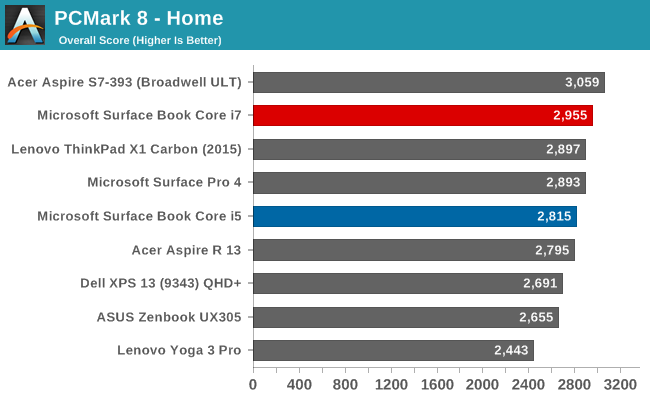
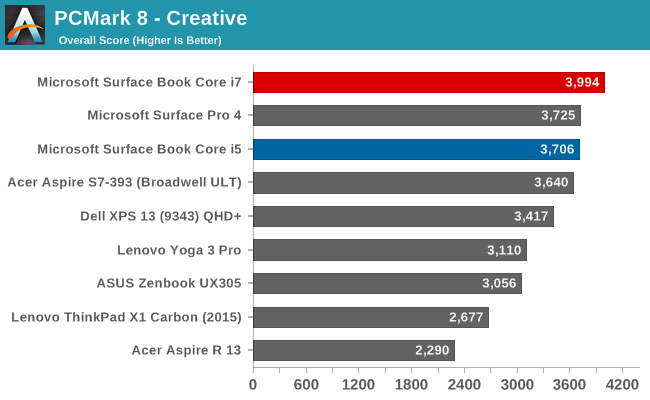
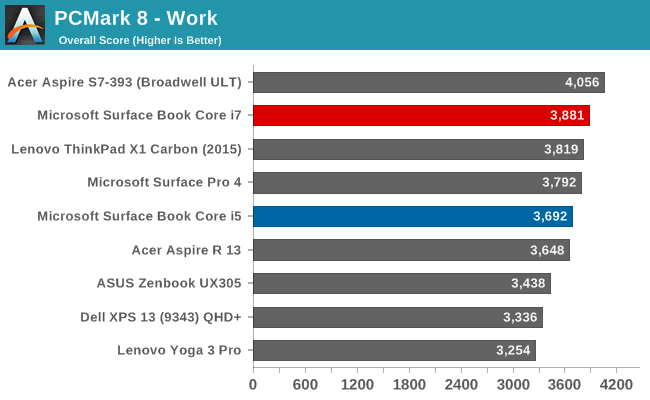
PCMark attempts to simulate real world workloads in several tests. Pretty much all factors of the device are tested, including storage, CPU, memory, and graphics. Skylake does pretty well in these tests, and while the Surface Book with Core i7 is not always the fastest, it is the fastest of any high resolution device.
Cinebench
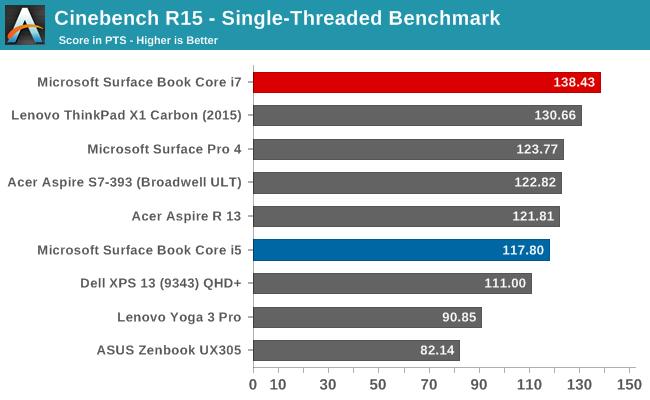
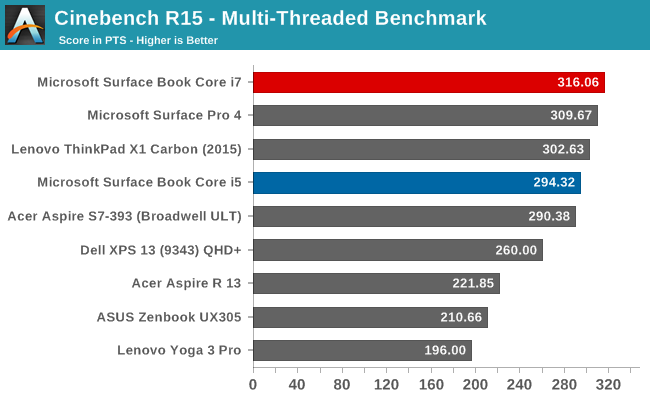
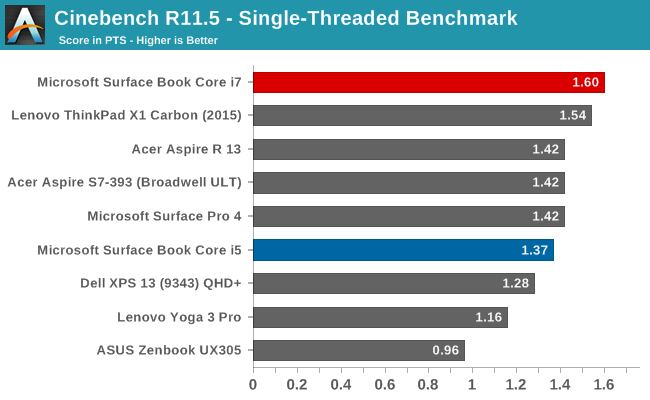
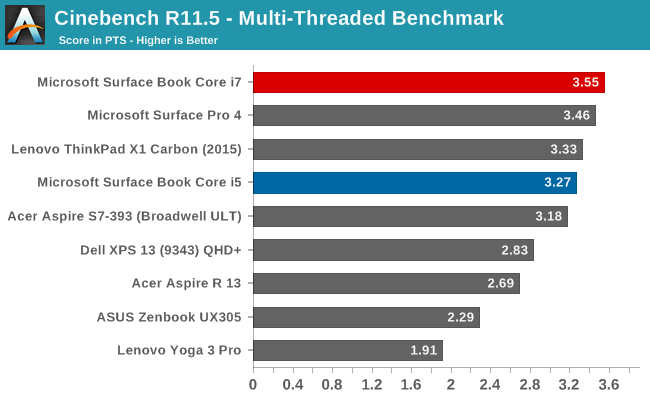
Cinebench performs rendering on the CPU, and more MHz and more cores can make a big difference on this test. Skylake does well here, especially on the multi-threaded workloads, but the i7-6600U shows a nice gain over the outgoing Broadwell Core i7 models.
x264
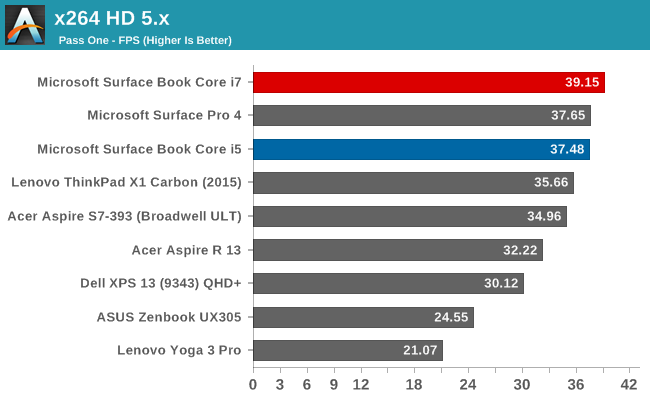

This test converts some video files, and much like Cinebench, it’s a mostly CPU bound test. Skylake does very well at this, but surprisingly the Core i7 model was slightly slower than the i5 on at the second pass.
Web Benchmarks
Browsing the web is something all of us do, so performance here is important. In the end, we can test JavaScript performance, but this is a test of more than just the CPU, since much of the performance is derived from the browser’s scripting engine. Previous to Windows 10, we had used Google Chrome since IE 11 was not representative in terms of performance, but with Edge now available in Windows 10, we’ve moved to that browser. Some of the tests will show an increase over Chrome with Edge, and some will show a decrease, so I’ve labeled all of the graphs to show which browser was used.
In addition, Intel’s Speed Shift is not yet available in Windows 10, so the scores do not have this enabled except where indicated to show the difference in the upcoming build of Windows 10. Once the patch is confirmed to be out, I’ll update Bench with the new values.

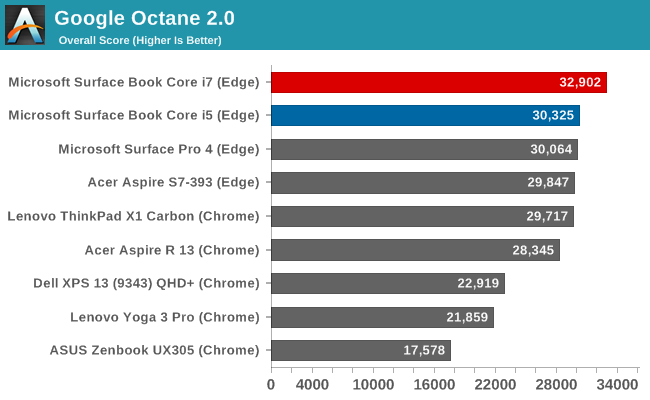
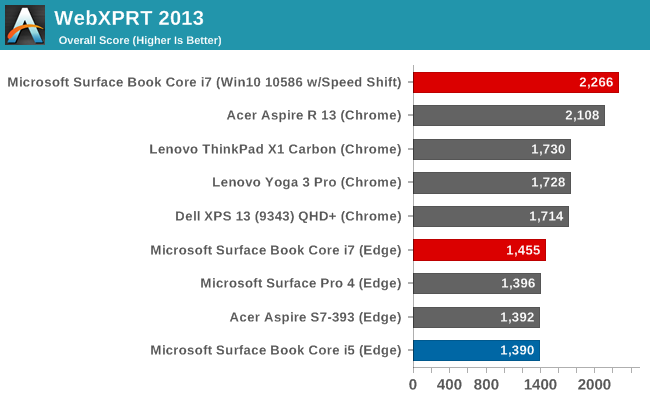
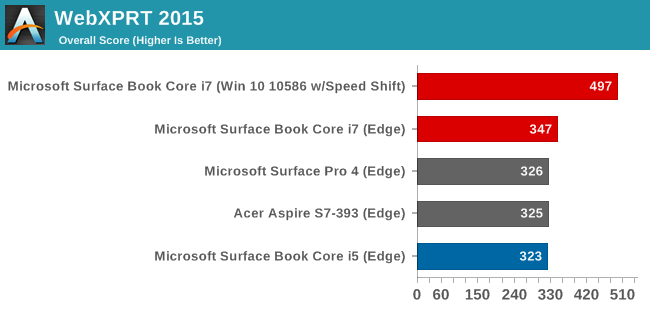
Like with the Surface Pro 4, performance on these tests is very good, with Skylake being able to outclass all of the previous generations of processors from Intel. We’ve already given you a preview of how this well change too when Speed Shift does get enabled on Windows 10, so expect these scores to go up a bit more too.
Storage Performance
With the Surface Pro 4, and Surface Book, Microsoft has moved to the cutting edge of storage technology. All of the flash storage is now based on NVMe, and the use of PCI-E 3.0 gives the system significantly more bandwidth than SATA ever could. While this is not quite the jump a SSD was to a HDD, for SSDs, it’s a big jump in overall performance.
On the Surface Pro 4 we had a 256GB Toshiba XG3 NVMe drive, and it was somewhat hampered by the number of NAND dies available. With the Surface Book that was provided for review, it is the full 512 GB model, and the extra NAND dies make a huge difference, especially on the write speeds. We see a tripling of the sequential write speed, up to 1.5 GB/s, and pretty much all of the other write speeds are doubled. This is some seriously fast storage, and any work with large files is almost comically fast.
There is some bad news though. On notebooks, it is not uncommon to see components dual-sourced from multiple vendors. This can be for a number of reasons, and recently we have seen it in the iPhone 6s which sources it’s SoC from two vendors. Microsoft has gone down this road with the Surface Book, meaning there are going to be two versions of SSD available. The first is the very fast Toshiba that we’ve just seen, but the second is not quite what I would have expected in a high end device.
Microsoft has gone with the Samsung PM951, which is similar to the Samsung SM951 that we’ve reviewed in the past. It is still a PCIe 3.0 x4 NVMe drive, but there is one crucial difference between it and the SM951. The PM951 uses Triple-Level Cell (TLC) NAND rather than Multi-Level Cell in the SM951. TLC has some drawbacks, which are lower durability and slower write speeds. I’ll recommend reading our TLC primer to get into the technical reasons for this, but I have some concerns with TLC NAND being used in the Surface Book in particular, mostly because of its position in the marketplace.
You can see that read speeds are still quite good, even surpassing the Toshiba some of the time, but write speeds are quite a bit lower. In particular, the sequential writes can be less than half the speed of the XG3 drive. This can be compensated for by using some SLC (Single-Level Cell) as a cache, but it does not appear that the PM951 has any caching available to it.
Also, these speeds are tested with the 512 GB drive, and lower capacity drives are going to have slower performance across the board due to the lack of parallelization of the NAND itself.
Let’s take a look at another test though. PCMark 8 uses traces from real-world applications to create their own storage test.
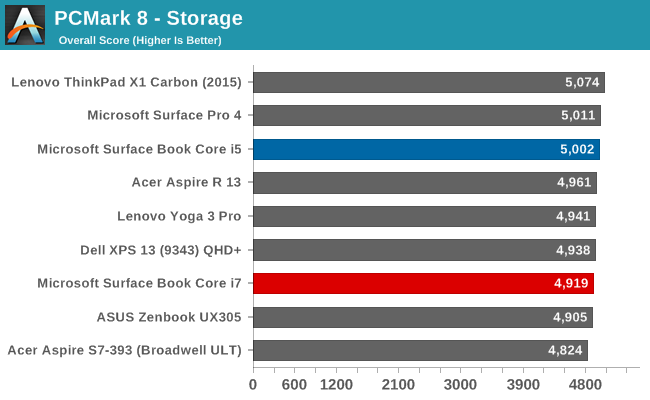
Here we can see that the Samsung drive actually scores a bit higher than the Toshiba. PCMark 8 tends to lump SSDs together, almost regardless of absolute performance. For many tasks, you just are not going to notice the slower write speeds of the Samsung drive. It would only be in cases where you are writing very large files to the drive, and where you are not already limited by another bottleneck (such as a USB drive so some other external device) where you are going to notice.
Summing the storage up, we have a situation that is not ideal. It’s fine to source from different vendors, but the performance differences between the two devices are quite substantial, let alone the long term durability of the TLC NAND. It was a decision done for the wrong reasons. It’s great that Microsoft has paid enough attention to storage to move to NVMe based drives, but then they have created a headache for themselves by sourcing drives with such different performance levels. If they had used the more expensive Samsung SM951, I don’t think there would be a discussion here. Many customers may not notice the speed differences, but that does not excuse the decision. Some customers will notice. On a premium device like the Surface Book, I would expect only the best, and while the drive may meet their internal performance levels, a cacheless TLC based SSD in a premium device is not necessary.


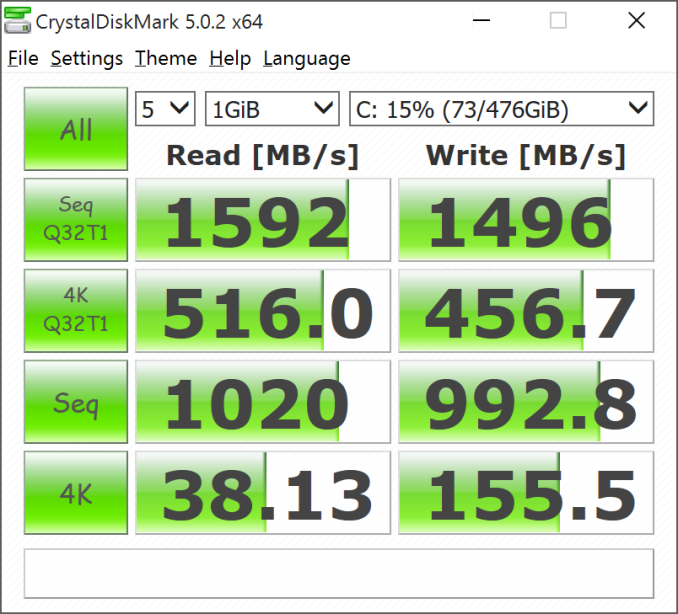









249 Comments
View All Comments
s.yu - Sunday, November 15, 2015 - link
I want to upvote you, Anandtech should add the feature.Vicli - Thursday, November 12, 2015 - link
Whether the surface book PCMark8 work score is improved by its dGPU?how many scores will be improved compared to w/o dGPUeldakka - Thursday, November 12, 2015 - link
The configuration options seem terribly limited. Why can't the SSD options be completely selectable, 128GB-1TB, independent of the amount of RAM or CPU chosen?A 12.1" version (with suitably down-rated components as necessary for the smaller form-factor) with USB-C on the tablet would be tempting if priced right.
s.yu - Sunday, November 15, 2015 - link
I never reckoned this would bother someone. Anyone who only needs 8GB of RAM shouldn't need any more than 256GB of SSD, and anyone who needs 16GB of RAM shouldn't need less than 256GB of SSD, should be the norm.But the real reason should be to prevent people getting 16GB/128GB and swapping out the SSD by themselves ;)
This doesn't seem possible now, but should be possible in the future with more SSD models released, also in "free" markets like China they'll be available on the web when spare parts are abundant.
BrokenCrayons - Friday, November 13, 2015 - link
The problem with the Surface Book's top-heavy tendencies is only partly mitigated by the hinge. We have a couple at work and people who are using them say they're still pretty unstable. I think getting rid of the upper battery and removing the detachment mechanism would have gone a long way in giving the Surface Book better balance. The other problem the hinge design introduces is the gap which means that when the SB is closed, it won't have the benefit of the upper and lower halves of the system acting in a mutually supportive manner to forces accidentally applied to the top or bottom which might result in unintended bending that wouldn't have happened with a better hinge that allows the screen to rest onto the base.I really think Microsoft would have a better product in the second generation if they move all the electronics to the base and deepen it somewhat so the motherboard and battery can all fit. They could also recess the keyboard into the base so the tops of the keys are flush. The screen could be made thinner to make up for some of the extra base thickness and the hinge could be redesigned to remove the flaw of it's big gap that not only demonstrates sloppy design, but also is unappealing to the eye. A good target for Microsoft to model their computer after would be the Latitude e6440 laptop which is a lot more capable, suffers none of the balance problems, and has a very nice keyboard, but I don't think MS would be able to offer it at a competitive price point. The existing SB cost is extremely high for the given hardware and ought to be lower given the flawed hinge and poor design decision with the raised keyboard.
s.yu - Sunday, November 15, 2015 - link
You're absolutely right about those two issues. But since this still is a Surface, MS will have to make it part tablet no matter what, IMO.Instability in the lap is still reported occasionally in reviews, no doubt due to the top-heavy construction, and as I said before, they should use lithium alloy like Lavie Z only in the top portion to deal with this, but some fanboys disagree. Nothing's gonna change the design of their "ultimate laptop"!
One reviewer made the strangest decision to step onto the hinge with the Book open to see if it held. I think he's just a fanboy trying to deceive people into thinking the design is flawless because no force IRL would be applied that way. If he stood on the middle of the *tablet* section, with the Book *closed*, and the tablet section/Surface connectors still didn't snap, that would answer the question.
Total Meltdowner - Friday, November 13, 2015 - link
Slowly but surely, the mutation which is a "tablet computer" is evolving back into a regular laptop. Hilarious.chrisnyc75 - Friday, November 13, 2015 - link
Great review! But I'd like to see it updated with results vs the new Dell XPS 15 (skylake & 960m) rather than last year's Haswell model, at least on the gaming tests if not all of them (though I think it would be an apt comparison point for all of the tests as the XPS 15 is roughly the same size/weight as the Surface Book, and prominently features 4k touch-screen as a primary feature, even if it's not actually a 2-in-1. A lot of people are still going to see the XPS 15 (not just the 13) as a direct alternative to the Surface Book)s.yu - Sunday, November 15, 2015 - link
1. I don't think it supports pen input. Short as the battery life on the clipboard is it's useful for note taking.2.It's still noticably bigger, and...does it still have that big battery option from the old model? Otherwise the battery would be really small.
chrisnyc75 - Sunday, November 15, 2015 - link
All good questions, and exactly why I'd like to see the XPS15 added to the comparison. Sure, the SB detaches, which can be useful, but the very existence of the Surface Book is owed to the fact that tablet sales have been in rapid decline across the market. Putting that bit aside (which I realize is missing the whole point of the Surface Book), they're almost exactly the same size & weight, both ~4k resolution, both touchscreens, & both Skylake + nvidia dgpu. As long as you're only pitting the SB against other detachable devices, it's ALWAYS going to come out on top because MS hit a home run with that part....but does anybody care? Enough to overlook a cheaper option (Surface Pro) or one with more power (XPS)? I personally would like to see the nitty-gritty comparison of the two before I decide.